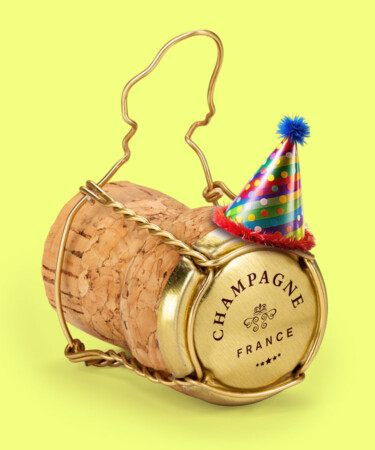One of the many unique aspects of Champagne is that a majority of the bottles are labeled as non-vintage (NV), meaning that the final wine is a blend from several harvests — sometimes dating back decades or even centuries. Only in the region’s best years can the winemakers declare a vintage and make a bottling entirely from that particular harvest. While blending wines from across years helps producers keep their flagships consistent, the lack of date on the label can often leave consumers wondering when exactly the wine they’re drinking was bottled.
Let’s say you find an interesting sale on Champagne from someone’s cellar at a boutique wine shop, but when you go to look at how old the wine is, the only information given is “NV.” How can you determine if the wine was recently bottled or has been sitting in a dusty corner for decades? There are some external signs that could clearly point to whether the wine is new or old: The condition of the bottle or the label design itself can both be hints. Some of the more geeky producers will even put the disgorgement date on the back and some grower-producers — many of which only make single-vintage wines — stealthily indicate the base vintage in an alphanumeric code on the bottle.
If you’re unable to find the secret cipher that unlocks the age of the wine and there’s no visible wear and tear on the bottle, the best way to determine how old the wine is to just pop it. The shape of the cork can actually change in the bottle over time, so make sure not to send it flying when you open the bottle and take a good look.
When a sparkling wine is bottled after disgorgement, the cork is typically cylindrical with straight edges, like one that you might find when you open a still bottle of wine. As it sits in the bottle over time, the bottom of the cork starts to change shape due to the pressure and changes in elasticity.
According to Emily Chen, a sommelier at La Compagnie Flatiron, a new outpost of wine bar La Compagnie des Vins Surnaturels in New York City, people can look at the size and pliancy of the cork to determine age. Typically, when you pop a bottle of Champagne, the bottom of the cork will expand back to its original shape, causing its classic flared-out or ballooned look. But if you pop the cork and the bottom section doesn’t expand outward, that’s a sign that the cork has lost its elasticity.
Chen also notes that as more producers stray from natural corks, this might not always be the case. “It used to be that you could roughly guestimate that a wine was old if the ‘stem’ of the mushroom cap was super compressed from time spent aging Champagne under cork,” she says. “But as of recently, due to widespread usage of the Mytik Diam agglomerated corks, there isn’t a crazy amount of consistency with how these affect Champagne aging and vice versa.”
It’s not an exact science, but observing the state of the cork can provide an interesting insight into a mysterious sparkling wine find or just make for a fun, educational exercise. Some wine lovers have even shared videos displaying how dramatically the cork’s shape evolves over time.
Obviously, the characteristics of the wine itself can also indicate the age. If it has more bright fruit notes and a strong stream of bubbles, it’s likely fresh and young, whereas notes of dried fruit, roasted nuts, and toasted bread can mean the wine has seen some age. An older sparkling wine will likely also lose some of its signature bubbles and appear darker in color. So once you’ve opened a bottle, you might as well taste it and see!
